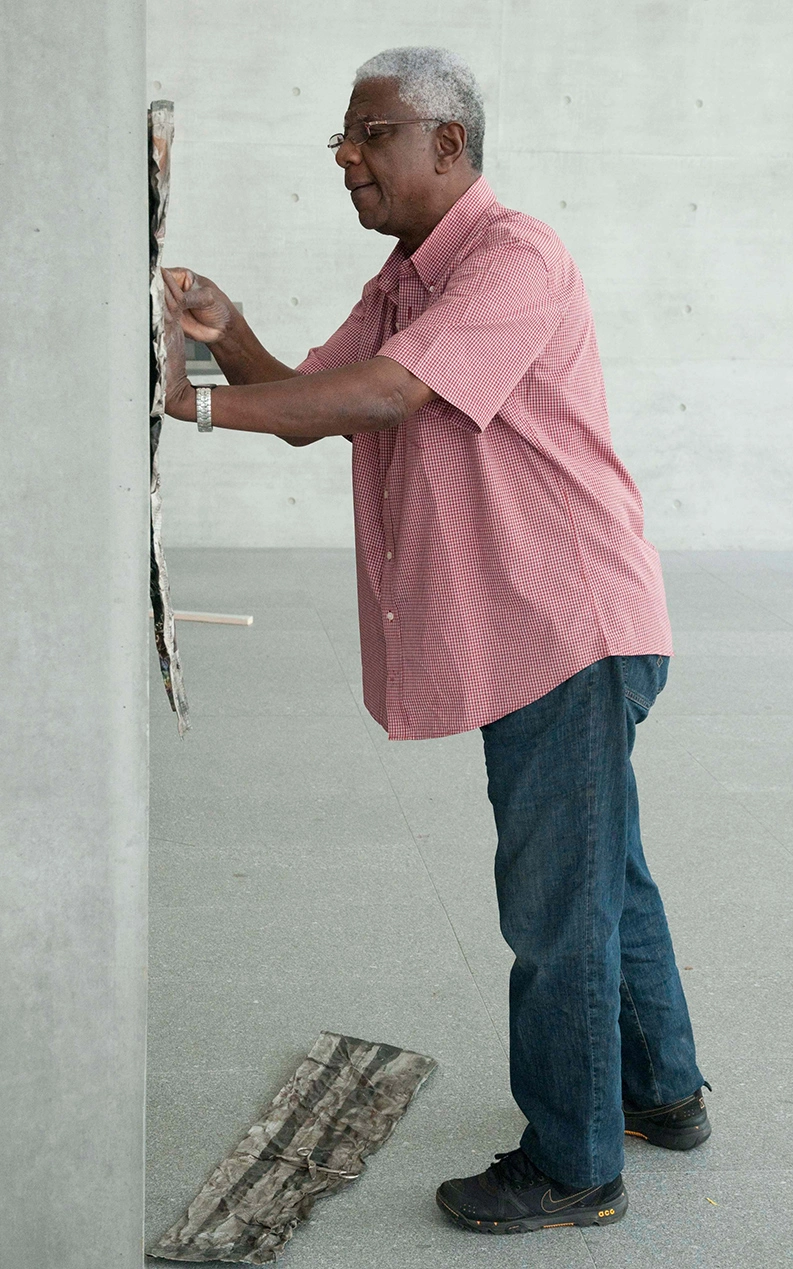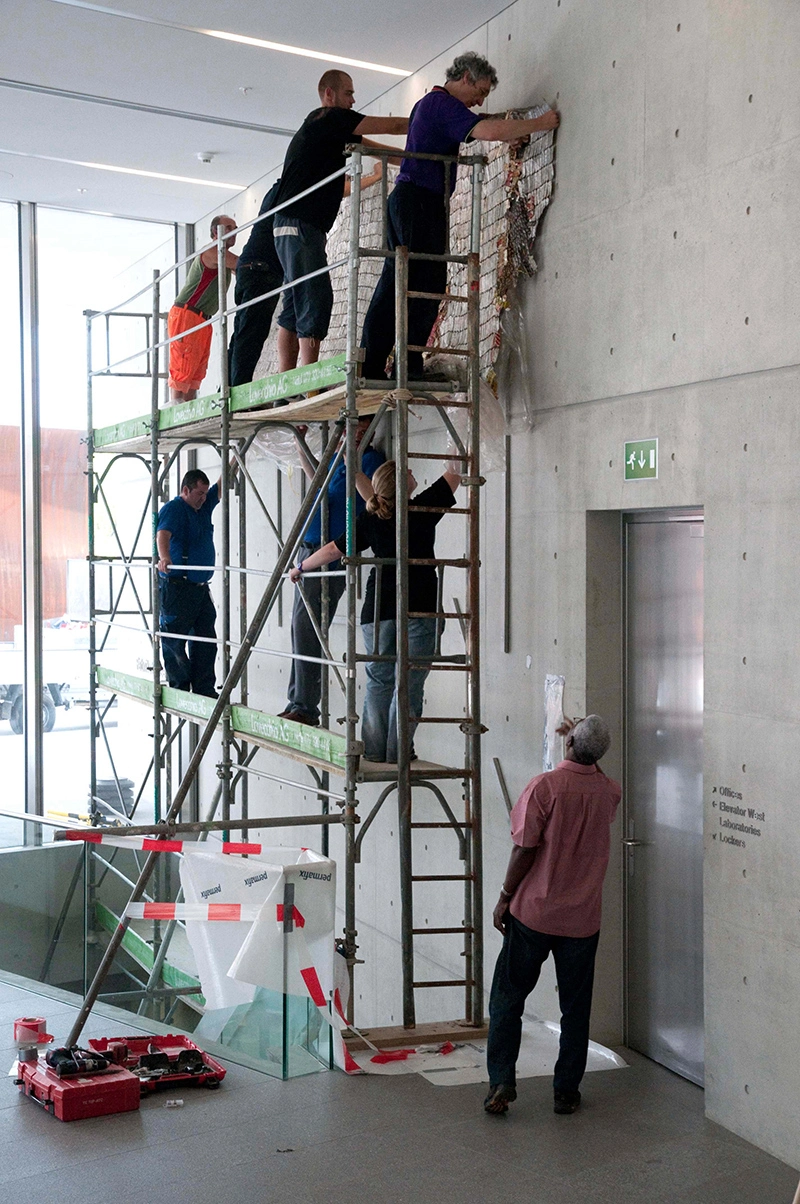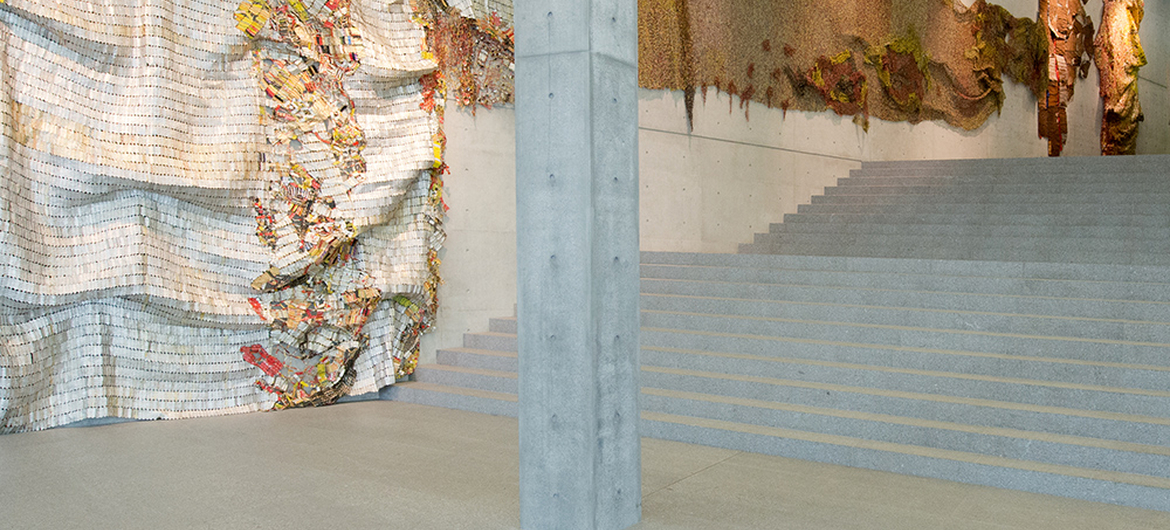Year: 2011
Material/Technique: Aluminum and copper wire
Tismenskiblo is a sumptuous example of his world renowned sculptural practice. Using found objects as bottle caps, copper wire, and other bits of discarded material, Anatsui weaves, stitches, and composes grand wall-hanging sculptures. The physically imposing wall sculpture overwhelms the viewer, drawing him or her into its rich latticework of shimmering metals. Intricate patterns begin to emerge from the field, intimating movement and highlighting the work’s connection to tapestry—specifically the kente cloth native to Ghana. Both a beloved aspect of Ghanaian culture and an oft-exported tourist item, the cloth and its distinctive patterns allude to a modernizing and increasingly global African economy.
For Anatsui, the interplay between material and meaning creates a powerful visual metaphor for Ghana’s social and economic history. Anatsui explains, “[when] I first found the bag of bottle tops, I thought of the objects as links between Africa and Europe. European traders introduced the bottle tops, and alcohol was used in the trans-Atlantic slave trade. Europeans made rum in the West Indies, took it to Liverpool, and then sent it back to Africa. For me, the bottle caps have a strong reference to the history of Africa” (E. Anatsui quoted in E. Gee, El Anatsui: When I Last Wrote to You About Africa, exh. cat. Museum of African Art, New York, 2011, pp. 33-34) Anatsui’s keen sense of global interconnectedness as it relates to discrete local and collective histories informs much of his practice, tethering it to reality in a manner that eludes many abstract artists. Each formal decision is deeply considered, leading to a finished product that appears, paradoxically, almost improvisational.

When El Anatsui visited Basel in July 2011 for the installation of Tismemskiblo, there were two huge crates standing in the entrance hall of the Ando building. Inside them, the artwork lay folded and layered in loose fragments of varying sizes. These parts were spread out on the floor, measured, linked together with copper wire, and shaped to purpose. Right up to the moment when the installation was completed, the artist continued to make compositional changes to the assemblage, adding volume to individual areas and allowing the fabric of the piece to fold and drape freely according to the inherent qualities of the material and its texture, as though it had simply been hung quite casually on the wall.
The enigmatic title “Tismemskiblo” given to this piece is a term containing references to “tissues”, “membranes”, “skin” and “blood”, ideas that were present in the artist’s mind whilst creating the site-specific commission for the Novartis campus.

Artist
Born in Anyako, Ghana in 1944, El Anatsui is widely recognised as one of the most important artists to emerge from the African continent in recent years. Through his practice, the artist transforms material such as wood, metal, clay and bottle caps into striking sculptural forms. El Anatsui moved to Nigeria in 1957 where he began his career by working with wood in a series of burnt, incised and painted panels.
He utilises traditional African techniques in order to promote discourse about memory and identity. The environment of West Africa, where the artist was born and currently works and lives, greatly affects the materials he incorporates in his artistic production. El Anatsui’s by chance encounter with a bag of bottle tops found in a bush would profoundly influence his practice and ultimately give life to his distinguishable installations. Although seemingly random, the bottle tops signified to the artist, the link between Europe and Africa. Throughout his work, El Anatsui seeks to promote the connectivity between Africa, America and Europe while simultaneously recalling the continent’s history of colonialism and Westernization. El Anatsui describes his work as constantly evolving, mirroring the progressive journey of a human life – perpetually in flux. Today, the artist is most celebrated for his glimmering mutable bottlecap wall hangings, which are characterised not only by their size but also their fabric like quality and reminiscence of traditional Kente cloth of the Ashanti people of Ghana.
His first major solo exhibition outside Africa took place in 1995 in London’s October Gallery. Since then, the artist has participated in several key exhibitions in Paris, Stockholm, Dusseldorf, Washington and Tokyo. In 2007, El Anatsui was invited to exhibit his works at the Venice Biennale. The artist has continued to achieve global recognition, having received prestigious awards such as the 2015 Venice Biennale Golden Lion for Lifetime Achievement and the 2009 Smithsonian National Museum of African Art 30th Anniversary Award, cementing his position as one of the world’s leading contemporary artists. His works can be seen in the collections of the Metropolitan Museum of Art in New York, The Centre Pompidou in Paris, the British Museum in London, Museum Kunst Palast in Dusseldorf, and several others.
